
The Facade and Queue Areas
The Architecture of the Disney Haunted Mansions
There is a popular quote attributed to Walt Disney. Upon being asked about the look of the Mansion building during the design process in 1962, he is said to have replied, "We'll take care of the outside, and the ghosts will take care of the inside." So despite Ken Anderson's early designs for a decrepit, dilapidated Manse, the existing Mansion facade (at Disneyland, at least - see photo below) is kept looking clean and serene. Keeping with the New Orleans theme, the white plantation-style Mansion is captured forever in a turn-of-the-century moment, with fancy French Quarter-style wrought iron and fresh paint applied routinely.
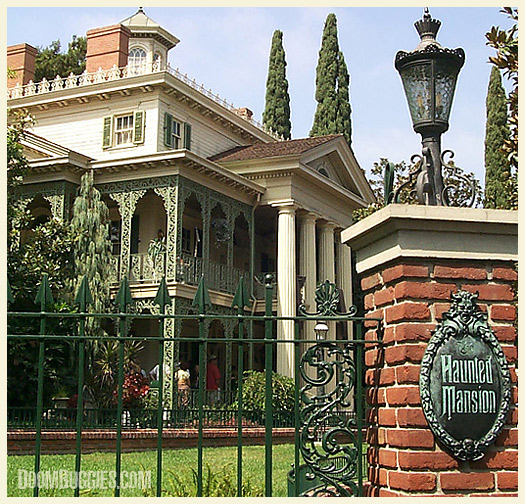
All about the theme
Although Disneyland's Haunted Mansion may most closely resemble Walt's personal vision, the other two Haunted Mansions (in Walt Disney World and Tokyo Disneyland) more closely resemble a haunted colonial manse, with large, imposing brick facades, heavy wrought iron, and landscaping that appears to have run amok (see photo, below). Where Disneyland's exterior theme relies on paint and cast iron, Walt Disney World's Mansion features heavy brick and patina. According to Imagineer Tony Baxter, the differences between the southern plantation look and the colonial fortress of Florida's facade are due, in part, to the existing architecture of the regions, and a desire to create something that doesn't seem too familiar to local guests.
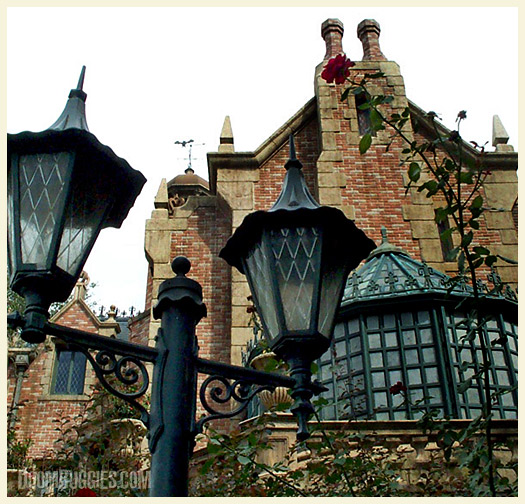
Though they are both based on the same blueprint, the Florida and Tokyo Mansions have a distinct personalities; the Walt Disney World version, located in a colonial-era section of the park called "Liberty Square," is overgrown with all sorts of flora, while the Tokyo Haunted Mansion (pictured below), located in Fantasyland, feels slightly more gothic and imposing, perhaps due to large bronze griffins that are positioned to stare at each guest that enters the gateway that they seem to be guarding.
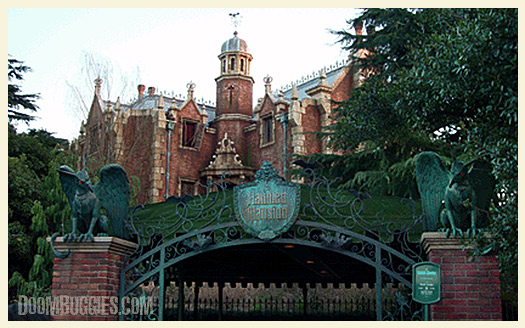
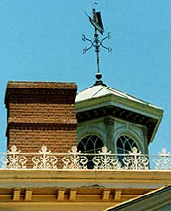 For
more information about the development of the facade architecture at the
various Haunted Mansions, click here.
For
more information about the development of the facade architecture at the
various Haunted Mansions, click here.
The weather vanes that adorn the various Mansions also give clues to what lies ahead for visitors. While the Walt Disney World and Tokyo Mansions sport vanes in the shape of a bat, the vane atop Disneyland's Haunted Mansion is in the shape of a ship, which is one of the few remaining hints toward some of the early show concepts that related to pirates, or a ghostly sea captain. To hear one of these stories as it was told by the Imagineers of WED back in the '70s, click here.


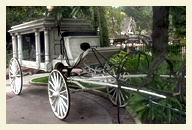
Brigham Young's Hearse?
Although it is widely rumored that Disneyland acquired the coach that carried Mormon Pioneer Brigham Young's body to its grave, it happens that this is just another one of the many myths that surround the Haunted Mansion.
According to Glen M. Leonard, director of The Church of Jesus Christ of Latter-day Saints' Museum of Church History and Art, said historical records are conclusive that the hearse couldn't possibly have been used for Young. "Historical evidence shows no hearse was used," he said, although he allowed for the possibility that the vehicle may be an authentic carriage from Young's era that originated in Utah.
The truth of the hearse's origins may never be known, but it can be said with reasonable certainty that neither Brigham Young (nor Joseph Smith, for that matter) were ever transported in this particular coach. It is also reasonably certain that no carriages throughout history have ever been pulled by invisible horses, though we give Disneyland extra credit for including the horseshoes in this clever display.

The Haunted Mansion Queue
The Haunted Mansions all have individual elements in the queue that give each its own character. For example, the Disneyland and Walt Disney World attractions have a hearse pulled by an invisible "ghost horse" (and the Disneyland hearse is popularly claimed to have been the same that actually contained Brigham Young's body at one time, though this rumor has been denied by Mormon historians. See sidebar, left.) The Walt Disney World hearse, however, is a bit famous, as it appeared with John Wayne in the 1965 Western "The Sons of Katie Elder."
Inside the Disneyland hearse, there is a rotting bouquet, along with an invitation to join the Mansion... or at least, to make a reservation (See photo below). The Walt Disney World Haunted Mansion also has a unique vault at the exit of the ride. Tokyo's Haunted Mansion has the eerie facade with huge griffins guarding the entry arch.
Pictured futher down the page is a detail of the bronze plaque announcing the entrance to the Haunted Mansion, which is found at the entrance to both the Disneyland and Walt Disney World attractions. Phantom Manor has a similar plaque at the entrance to its queue, though the demon on Phantom Manor's plaque bears an uncanny resemblance to Vincent Price, who was the voice of the Phantom Manor "Ghost Host" for a brief period of time. Also pictured below is the hearse that can be found in the Walt Disney World Haunted Mansion queue.
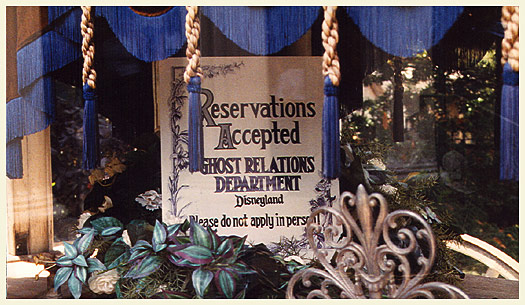
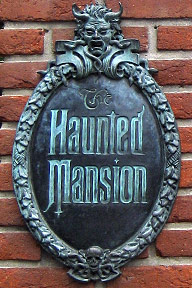 A
home where the Phantoms roam
A
home where the Phantoms roam
For a brief period of time in the '80s, costumed characters roamed the queue area of the Haunted Mansion in the form of cloaked "Phantoms," according to Jason Surrell in his book "The Haunted Mansion: from the Magic Kingdom to the Movies," though the "Phantoms" tracked down by DoomBuggies.com recall their territories as being limited to the inside of the attraction. Nevertheless, the queue area of the Haunted Mansion has always been meticulously themed and carefully landscaped, to ensure a properly set stage for the mysterious happenings to come within the walls.
Flora of the Mansion's grounds
A very important part of the queue decoration is the landscaping, and plant selections, which lend an aura of authenticity to the architectural settings proposed by the facade designs. The Tokyo and Walt Disney World Haunted Mansion grounds are carefully designed to appear overgrown and ancient, with roses growing into brambles and trees scaled to empasize the imposing nature of the brick and mortar facades (see photo, below right).
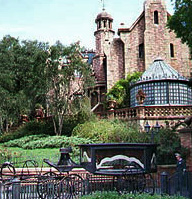 Disneyland,
on the other hand, contains plants that may be carefully groomed to maintain
a proper, well-tended apperance, while still offering a hint of sorrow,
in a wonderful landscape design by Disneyland's Bill Evans. As the Mansion
was placed in a pre-existing grove of Southern Magnolia trees, a few still
remain around the Disneyland facade. A neatly manicured lawn sets in front
of the Mansion, though it is adorned with carefully placed sections of Mondo
Grass, to give a loose, overgrown effect around planters and props. A number
of drooping plants and trees are used in the landscaping, to give a "weeping"
appearance, as if the plant life itself were in mourning.
Disneyland,
on the other hand, contains plants that may be carefully groomed to maintain
a proper, well-tended apperance, while still offering a hint of sorrow,
in a wonderful landscape design by Disneyland's Bill Evans. As the Mansion
was placed in a pre-existing grove of Southern Magnolia trees, a few still
remain around the Disneyland facade. A neatly manicured lawn sets in front
of the Mansion, though it is adorned with carefully placed sections of Mondo
Grass, to give a loose, overgrown effect around planters and props. A number
of drooping plants and trees are used in the landscaping, to give a "weeping"
appearance, as if the plant life itself were in mourning.
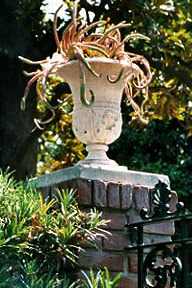 Medusa's
Head (pictured at left), Weeping Mulberry, and Weeping Juniper are all examples
of this style of planting. Calla Lily, Lambs Ear and English Holly are other
familiar varieties used in this careful display of vegetation. The groundskeepers
at Disneyland have a carefully compiled list of all of the plants in each
section of the park, including the grounds of the Haunted Mansion, and DoomBuggies.com
has obtained a copy. Click here to read
it.
Medusa's
Head (pictured at left), Weeping Mulberry, and Weeping Juniper are all examples
of this style of planting. Calla Lily, Lambs Ear and English Holly are other
familiar varieties used in this careful display of vegetation. The groundskeepers
at Disneyland have a carefully compiled list of all of the plants in each
section of the park, including the grounds of the Haunted Mansion, and DoomBuggies.com
has obtained a copy. Click here to read
it.
In memorium
A mansion could hardly be considered "haunted" if it didn't have a family graveyard adjacent to it, and Disney's Haunted Mansions are no exception. Read on to learn about the various memorials on the grounds of the various Mansions...



